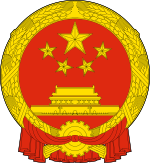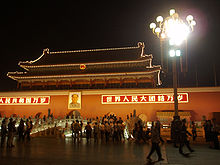Coat of arms of the People's Republic of China
| Coat of arms of the People's Republic of China | |
|---|---|

|
|
| Details | |
| Introduced | 1950 |
| Heraldic shield | Gate of Heavenly Peace |

The coat of arms of the People's Republic of China was adopted in 1950.
description
The coat of arms of the People's Republic of China (Chinese: 中华人民共和国 国徽; Pinyin: Zhōnghuá Rénmín Gònghéguó guóhuī) shows the golden gate of Heavenly Peace in red , illuminated by four golden faceted five-pointed stars that form a semicircle around a larger star.
The circular coat of arms is framed by a golden wreath of ears of corn with a golden cog wheel and a red draped flag at the bottom.
symbolism
The Gate of Heavenly Peace is the southern entrance to the Forbidden City , from whose balustrade Mao Zedong proclaimed the People's Republic of China on October 1, 1949.
The big star symbolizes the Communist Party , the four smaller stars symbolize the “four classes” - workers , peasants , intellectuals and the national bourgeoisie - on which the political power of the People's Republic of China is to be based. The arrangement of the stars around the large star that forms the center shows that the unit should be formed through a center.
There are different interpretations of what the four stars stand for. According to the Fischer Weltalmanach 2006, the four little stars stand for workers, peasants, petty bourgeois and patriotic capitalists. The original description by the designer of the flag, Zeng Liansong, sees the general bourgeoisie represented by the fourth star.
The ears of wheat and rice symbolize the farmers again, the cogwheel the workers. There is no reference to intelligence , such as in the coat of arms of the GDR through the circle, in the coat of arms of the People's Republic of China.
history
The National Coat of Arms of the People's Republic of China was adopted by the Political Consultative Conference of the Chinese People on June 23, 1950 . The official German translation of the Chinese constitution from 1982 reads:
"The national coat of arms of the People's Republic of China shows in the middle the Gate of Heavenly Peace , outshined by five stars , surrounded by a wreath of ears, including a cog."
Shortly before the People's Republic of China was founded in 1949, Qinghua University and the Central Institute for Fine Arts were commissioned to establish a special group to design a national coat of arms. By comparing the submitted proposals, a decision was made in favor of a draft developed by the professors of Qinghua University and the Central Institute for Fine Arts.
This draft coat of arms and its explanation was adopted on June 18, 1950 in the second plenary session of the Consultative Conference and announced on September 20, 1950 by order of Mao Zedong .
The following anecdote is handed down about the creation of the national coat of arms : In the winter of 1942, Zhou Enlai was a guest at Song Qingling's in Chongqing and saw two ears of grain on the table that farmers had sent. In response to the remark that these ears of corn were like gold, Song Qingling said:
“You are more valuable than gold! 80 percent of the Chinese population are farmers. If there is a rich harvest year after year, the people can lead a prosperous life. "
Zhou Enlai said:
"When our country is liberated, we have to include the ears of wheat in the national coat of arms."
When the national coat of arms of the People's Republic of China was drafted, Zhou Enlai, as Prime Minister, made this proposal, which was then implemented.
literature
- Karl-Heinz Hesmer: Flags and coats of arms of the world. History and symbolism of the flags and coats of arms of all states. Bertelsmann Lexikon Verlag, Gütersloh 1992, ISBN 3-570-01082-1 .
Web links
- Flag lexicon (description of flag and coat of arms)
